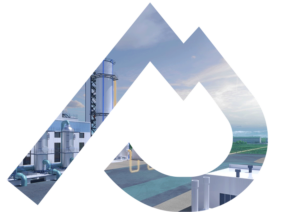
CCUS chain :
a key lever in the National
Low-Carbon Strategy (SNBC)
Industrial decarbonisation uses different processes to reduce greenhouse gas emissions. Those processes prove effective at multiple stages of the production cycle, through the optimisation of installations, production processes and energy consumption. However, part of the residual CO2 remains when the fumes are evacuated. At this final stage, the CCUS chain plays a crucial role in contributing to carbon neutrality.
CCUS as a French national strategy
The French State acknowledges the importance of mobilising CCUS in the fight against climate change and supports its implementation on an industrial scale. In time, it aims to develop storage capacities on the national territory, as an alternative to transfers to offshore sites under the North Sea and the Mediterranean.
Definition of CCUS
CCUS (Carbon Capture, Utilisation and Storage) technologies are a necessary solution to reduce GHG emissions and meet the commitments set out in the Paris Agreement.
They are aimed at the elimination of residual carbon only and therefore come into play at the end of the industrial cycle, once all decarbonisation measure have been applied. CO2 capture and sequestration are thus seen as complementary to energy efficiency actions, within a single carbon neutrality plan.
Visit the “CCUS Zero CO2 objective” educational website developed by Teréga, to familiarise yourself with all aspects of the value chain:
The CCUS strategy deployed by France
The deployment pathway established by the CCUS national strategy defines three main phases between 2025 and 2050.
The first industrial-scale implementations are planned for 2025 to 2030, to meet the deadlines set by the EU aimed at reducing greenhouse gas emissions. CCUS hubs will then be developed in the most active industrial port areas of the French seaboard, with the aim of transferring CO2 to the storage points at sea.
From 2030 to 2040, following studies, the geological sites in the territory with a claim to secure CO2 sequestration will be exploited with the aim of achieving State sovereignty.
Finally, the capture process will be extended to other activities and secondary industrial emitters, in order to extend the national and European CCUS grid.
Links in the CCUS chain

Residual carbon dioxide capture
Capture consists in extracting the residual CO2 present in discharges from an industrial site that has already exploited all decarbonisation solutions at its disposal, then concentrating it. This means the carbon dioxide is separated from other chemical molecules, so that it can be purified, dehydrated and transformed again into a compressed or liquid state, ready for transport.
Various technologies are used to capture CO2. Post-combustion is the most commonly used form, and takes place at the end of chimneys and flues where fumes are evacuated.

Transport of purified CO2
There is a number of possible logistical approaches to this (pipelines, lorries, ships etc.). A crucial stage in the CCUS plan, the transport of captured CO2 (from the emitting site to the place of use or storage at sea or on land) is carried out in a secure manner.

Use of the captured carbon dioxide
The CO2 arising from capture can be used in a number of ways. As a raw material, it contributes to the production of sustainable fuels, also known as e-fuels, plastics or greener construction materials. It is also used for cryogenic food processing or water treatment.
The combination of CO2 and hydrogen, moreover, allows it to be used as a fuel, such as methane or methanol. The production of sustainable fuels is particular interest to aviation and maritime transport.

CO2 storage
Two methods can be used to store it underground. At sea (offshore), deep salt aquifers composed of porous and permeable rocks offer significant storage capacity. On land, it is chiefly depleted deposits (old sites that formerly contained oil or gas but have now been emptied), that have the capacity to hold the millions of tonnes of captured CO2 in a safe, permanent way. In France, geological formations that have the necessary characteristics for CO2 injection or sequestration have been identified and are the subject of detailed studies to confirm the feasibility of such a project. This national storage option would significantly reduce the costs on industry and increase competitiveness.
CCUS chain FAQs
It encompasses technologies for capturing, transporting, storing and utilising residual carbon from industry (Carbon Capture, Utilisation and Storage), following the implementation of all decarbonisation actions applied to the production cycle.
It has a role as one of the ways of reducing greenhouse gas (GHG) emissions. The processing of incompressible residual CO2 from industry is encouraged by the IPCC, ADEME and the International Energy Agency. It satisfies the requirements of the National Low-Carbon Strategy and those of the European Green Deal.
Implementation of the CCUS chain is a lever for safeguarding French industry and the jobs that go with it, as well as being a necessary solution for its transition. By offering an alternative way of transporting and storing CO2 in the territories where the biggest industrial actors are based, it allows a massive reduction in costs and improves their profitability.
